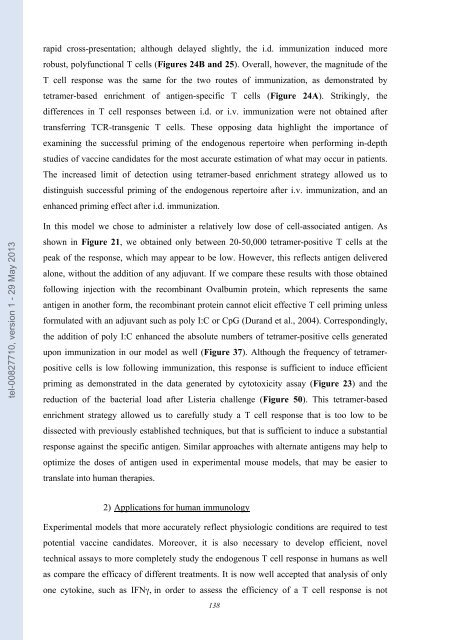Voie d'immunisation et séquence d'administration de l ... - TEL
Voie d'immunisation et séquence d'administration de l ... - TEL
Voie d'immunisation et séquence d'administration de l ... - TEL
Create successful ePaper yourself
Turn your PDF publications into a flip-book with our unique Google optimized e-Paper software.
tel-00827710, version 1 - 29 May 2013<br />
rapid cross-presentation; although <strong>de</strong>layed slightly, the i.d. immunization induced more<br />
robust, polyfunctional T cells (Figures 24B and 25). Overall, however, the magnitu<strong>de</strong> of the<br />
T cell response was the same for the two routes of immunization, as <strong>de</strong>monstrated by<br />
t<strong>et</strong>ramer-based enrichment of antigen-specific T cells (Figure 24A). Strikingly, the<br />
differences in T cell responses b<strong>et</strong>ween i.d. or i.v. immunization were not obtained after<br />
transferring TCR-transgenic T cells. These opposing data highlight the importance of<br />
examining the successful priming of the endogenous repertoire when performing in-<strong>de</strong>pth<br />
studies of vaccine candidates for the most accurate estimation of what may occur in patients.<br />
The increased limit of d<strong>et</strong>ection using t<strong>et</strong>ramer-based enrichment strategy allowed us to<br />
distinguish successful priming of the endogenous repertoire after i.v. immunization, and an<br />
enhanced priming effect after i.d. immunization.<br />
In this mo<strong>de</strong>l we chose to administer a relatively low dose of cell-associated antigen. As<br />
shown in Figure 21, we obtained only b<strong>et</strong>ween 20-50,000 t<strong>et</strong>ramer-positive T cells at the<br />
peak of the response, which may appear to be low. However, this reflects antigen <strong>de</strong>livered<br />
alone, without the addition of any adjuvant. If we compare these results with those obtained<br />
following injection with the recombinant Ovalbumin protein, which represents the same<br />
antigen in another form, the recombinant protein cannot elicit effective T cell priming unless<br />
formulated with an adjuvant such as poly I:C or CpG (Durand <strong>et</strong> al., 2004). Correspondingly,<br />
the addition of poly I:C enhanced the absolute numbers of t<strong>et</strong>ramer-positive cells generated<br />
upon immunization in our mo<strong>de</strong>l as well (Figure 37). Although the frequency of t<strong>et</strong>ramer-<br />
positive cells is low following immunization, this response is sufficient to induce efficient<br />
priming as <strong>de</strong>monstrated in the data generated by cytotoxicity assay (Figure 23) and the<br />
reduction of the bacterial load after Listeria challenge (Figure 50). This t<strong>et</strong>ramer-based<br />
enrichment strategy allowed us to carefully study a T cell response that is too low to be<br />
dissected with previously established techniques, but that is sufficient to induce a substantial<br />
response against the specific antigen. Similar approaches with alternate antigens may help to<br />
optimize the doses of antigen used in experimental mouse mo<strong>de</strong>ls, that may be easier to<br />
translate into human therapies.<br />
2) Applications for human immunology<br />
Experimental mo<strong>de</strong>ls that more accurately reflect physiologic conditions are required to test<br />
potential vaccine candidates. Moreover, it is also necessary to <strong>de</strong>velop efficient, novel<br />
technical assays to more compl<strong>et</strong>ely study the endogenous T cell response in humans as well<br />
as compare the efficacy of different treatments. It is now well accepted that analysis of only<br />
one cytokine, such as IFNγ, in or<strong>de</strong>r to assess the efficiency of a T cell response is not<br />
138

















